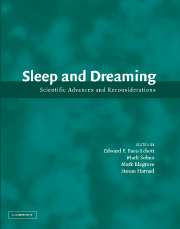Book contents
- Frontmatter
- Contents
- Preface
- Introduction
- 1 Dreaming and the brain: Toward a cognitive neuroscience of conscious states
- 2 Dreaming and REM sleep are controlled by different brain mechanisms
- 3 A review of mentation in REM and NREM sleep: “Covert” REM sleep as a possible reconciliation of two opposing models
- 4 The case against memory consolidation in REM sleep
- 5 The reinterpretation of dreams: An evolutionary hypothesis of the function of dreaming
- Open Peer Commentary and Authors' Responses
- References
- Postscript: Recent findings on the neurobiology of sleep and dreaming
- Index
Preface
Published online by Cambridge University Press: 11 January 2010
- Frontmatter
- Contents
- Preface
- Introduction
- 1 Dreaming and the brain: Toward a cognitive neuroscience of conscious states
- 2 Dreaming and REM sleep are controlled by different brain mechanisms
- 3 A review of mentation in REM and NREM sleep: “Covert” REM sleep as a possible reconciliation of two opposing models
- 4 The case against memory consolidation in REM sleep
- 5 The reinterpretation of dreams: An evolutionary hypothesis of the function of dreaming
- Open Peer Commentary and Authors' Responses
- References
- Postscript: Recent findings on the neurobiology of sleep and dreaming
- Index
Summary
For centuries there have been theories about how and why sleep occurs. Since the discovery of REM sleep in 1953, science has also asked how and why the individual stages of sleep, such as REM sleep and slow wave sleep, occur and what relationship they have with dreaming. The relationship of dreaming to brain physiology and neurochemistry, and the possible functions, or lack of functions, of REM sleep and of dreaming have also been addressed. This book highlights the current debates, disagreements, and understandings among many of the world's leading researchers, from many different disciplines, on these questions, including both theoretical and experimental work. The book comprises a collection of target chapters, commentaries, and replies to commentaries that were first published as a special issue on sleep and dreaming of the journal Behavioral and Brain Sciences in December 2000.
These are currently areas of great ferment. Fifty years ago dreams seemed to occur almost exclusively in REM sleep, a few years later dreams were also shown to occur in non-REM sleep, and the debate continues today about whether these stages of sleep result in different types of dreams or whether dreaming can occur in all stages of sleep and how closely characteristics of dreaming, such as the illogicality of some dreams or the ease with which they are forgotten, are tied to the physiology and neurochemistry of the brain. Theories of the function of dreams have abounded, from the clearing out of memories to the linking and forming of memories to creative problem-solving. There have also been theories of the function of REM sleep, such as of brain maturation in the newborn and the consolidation of memories at all ages.
- Type
- Chapter
- Information
- Sleep and DreamingScientific Advances and Reconsiderations, pp. ix - xPublisher: Cambridge University PressPrint publication year: 2003



